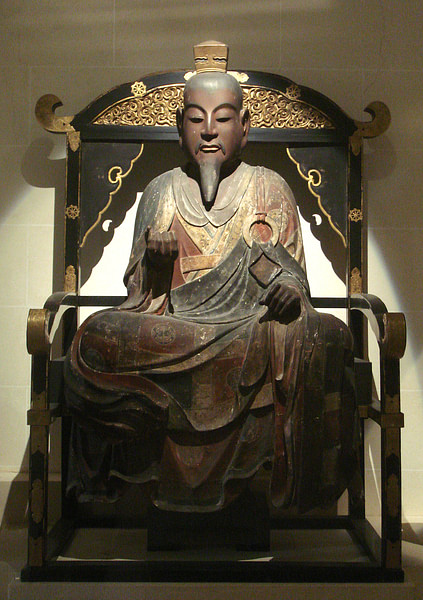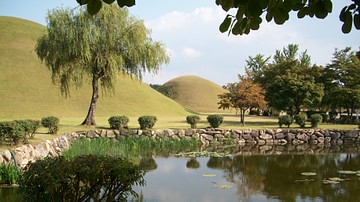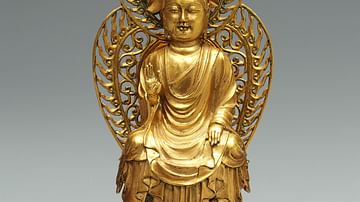In this interview, James Blake Wiener, Co-Founder and Communications Director at Ancient History Encyclopedia (AHE), speaks to Emeritus Professor James H. Grayson, Professor of Korean Studies at the University of Sheffield, about the historical and cultural impact of Buddhism in Korea through an anthropological lens.
Dr. Grayson's research interests lie in two main areas, the diffusion of religion across cultural boundaries, and an analysis of the religious and intellectual conceptual framework of the Korean and East Asian peoples. His research is broadly anthropological in approach with an interest in both the ancient and recent periods of Korean history. He has done fieldwork in Korea, Japan, and Okinawa. [BA (Rutgers), MA (Columbia), MDiv (Duke), PhD (Edinburgh)]
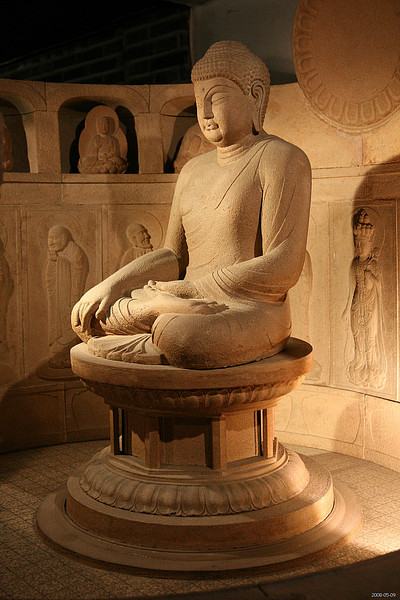
JBW: What was it that first attracted you to Korean history and Korean Buddhism? Had you always been interested in Korean culture, Professor Grayson?
JHG: Even when I was a small child (in the early 1950s), I was fascinated by East Asian culture and history – which essentially meant China. An interest in non-Western cultures led me to study anthropology and sociology as an undergraduate (Rutgers University) and later as a postgraduate (Columbia University).
In the summer of 1965, before my final undergraduate year, I spent a summer in East Asia as part of two work camps sponsored by the American Friends (Quaker) Service Committee – one in a mountain village in Fukushima Prefecture in Japan, and one in a fishing village in Ch'angwŏn County on the south coast of Korea. This confirmed my interest in East Asia and gave me an experience of life in two East Asian countries: Japan and South Korea. There was a huge economic difference between Japan and Korea in those days, but it was South Korea which was more interesting to me.
In 1967, through a Fulbright-sponsored programme at Columbia University, I was able (along with a group of other anthropology students) to spend a summer in Taiwan. This experience gave me yet another perspective on East Asia. On my return home to the US, I stopped off for a few weeks in Korea to renew acquaintance with friends and with the country. After theological training (Duke University), I was assigned to work with the Korean Methodist Church where I spent my working life until I joined the staff of the School of East Asian Studies at The University of Sheffield in the UK in 1987.
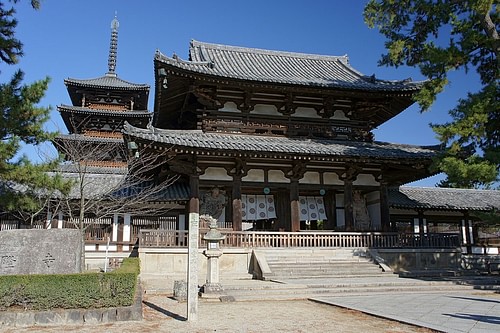
I cannot say that I always had an interest in Korea, or in Korean culture, or in Korean Buddhism. My interest in East Asia grew from a childhood interest in history and culture and was firmed up by two extensive experiences at an intellectually formative period of my life. It was these experiences which created my desire to live and work in Korea. As an anthropologist, and as a Christian, I was deeply interested in the ideas, beliefs, practices, and cultural expressions of Korean culture. This meant understanding Confucian thought and practice, Buddhist belief and cultural expressions, the folk religion of Korea (usually, and mistakenly, referred to as 'Korean shamanism'), and Korean Christianity, both Catholic and Protestant – particularly Christian social and cultural adaptations to a pre-eminently Confucian society.
My interest in Buddhism is both historic (i.e. how did Buddhism spread into and develop in Korea?) and contemporary (what is the condition and state of Buddhism in modern Korean society?). Broadly, my interest in Korean Buddhism is not at the level of doctrine or of practice (as important as understanding these matters is), but in the social and cultural processes in the growth and development of this religious tradition.
JBW: Could you contextualize the social and political variables that were at play when Buddhism first arrived in Korea from China? Was the reception and acceptance of Buddhism in ancient Korea marked by a degree of political expediency?
JHG: The spread of Buddhism into Korea began at a fairly early point in the history of the 'Three Kingdoms' — Koguryŏ (Goguryeo), Paekche (Baekje), and Silla — around the 4th century CE. In the early centuries of the first millennium CE, 'Korea' was several kingdoms and other political entities in central and southern Manchuria and the Korean peninsula. These were state-level polities which had a fairly sophisticated level of political and economic development and lay on the periphery of the Han Empire of China. With the demise of the Han Dynasty in the 3rd century CE and its split into a multiplicity of larger or smaller more or less ephemeral states, 'Chinese' culture began to spread significantly beyond the boundaries of the old empire. The diffusion of 'Chinese' culture into the areas of the kingdoms of Koguryŏ (Goguryeo), Paekche (Baekje), and Silla and the smaller Kaya (Gaya) states can be seen as a process of 'modernization' (to use an anachronistic term), raising the cultural and political standards of these states to the level of the most sophisticated culture known to them. The process can be seen as a package consisting of a system of governance, a political philosophy (Confucianism), a system of writing ('Chinese' characters), and religion (Buddhism), and the art and other cultural characteristics that go with them.
It is important to note that this process of the diffusion of culture took place during the period of disunion (from the collapse of the Han Empire in the early 3rd century CE to the emergence of the Sui Dynasty in the late 6th century CE). Many of these political entities were not larger than Koguryŏ (Goguryeo) and were ruled by 'barbarian' (in Chinese eyes) elites. In other words, this process of cultural diffusion took place at a time when there was no centralized 'Chinese' state, and when there was a broad geographic, political, and ethnic parity between the states in the Korean peninsula and Manchuria, and the states in the territory of the former Han Empire.
One interesting aspect of this spread of 'Chinese' culture was that it was done in part to develop diplomatic ties between the states in 'Chinese' territory with those in 'Korean' territory. Ancient records claim that the first Buddhist missionaries to Koguryŏ (Goguryeo) came from a state in what had been the northern part of the Han Empire, while the missionaries to Paekche (Baekje) came from an entity in what had been the southern part of the Han Empire. It is also claimed that Buddhism first came to Silla through the agency of a monk who came from Koguryŏ (Goguryeo). The 'Korean' states, in turn, adopted this policy in the spread of Buddhism to Japan where Buddhist monks as representatives of the ruling class in their nations were sent there to build diplomatic and political ties through the spread of culture.
I do not think that one should use the term 'political expediency' in regard to the spread of 'Chinese' culture and Buddhism to the 'Korean' states if by that you mean that the acceptance of new culture was forced on the ruling elites in those states. Rather, I think that it should be looked at as being part of the process of building a more sophisticated and 'modern' state, nation, and culture. Buddhism was the religious element of the 'Chinese' cultural package.
JBW: While Buddhism came to Korea via China, it is important to emphasize the role of Korean monks in the dissemination of Buddhism. Could you tell us more about those Korean monks who traveled to China and India in order to acquire new knowledge, texts, and discover new branches of the religion? How did their activities shape Buddhism in Korea and attract converts?
JHG: From a very early period, certainly by the mid- to late 6th century CE, monks from Koguryŏ (Goguryeo) and Paekche (Baekje) went to key monasteries in the territory of 'China' to study and made pilgrimages to famous Buddhist sites to have a religious experience. This was natural as 'Korean' monks would see 'China' as the source of their religion and would go there to deepen their knowledge and their experience. When they returned, they would bring back with them not only their knowledge and their experience but also texts (scriptures and textual commentaries) and works of art (statues, paintings, etc).
But we have to avoid seeing this movement of monks from one part of East Asia (modern Korea) to another part of East Asia (modern China) as if it were a movement between modern nation states. Rather this movement is more like the movements and travels of the monks and scholars of medieval Europe who moved around from place to place on the continent. One should not talk at this stage about national religions in East Asia such as Chinese Buddhism or Korean Buddhism. It is East Asian Buddhism and East Asian Buddhists. A common cultural world was developing, one in which the socio-political philosophy was Confucianism and the religion Buddhism. It was one cultural world, with many political entities. It was the interchange between the parts of the common cultural world which spread and deepened the practice of Buddhism, the extension of its artistic and architectural traditions, and the intellectual traditions to explain Buddhist beliefs and ideas.
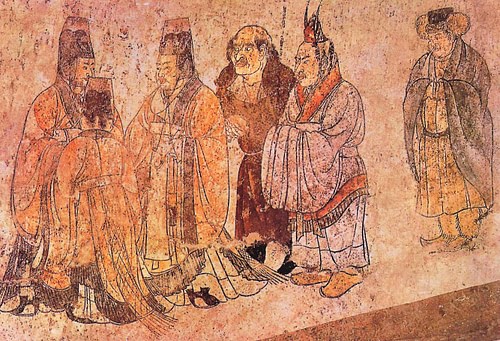
By the 6th century CE, there was another movement of monks which is important – the travels of 'Korean' monks to India. From the 5th century CE, 'Chinese' monks had made the arduous journey through Central Asia, and over the great mountain ranges into the northern plains of India. They made their way on pilgrimage to the sacred sites of Buddhism and went to study in the great centers of Buddhist learning in India. It was in the next century that we see 'Korean' monks doing the same thing; they were going to the source of their religion. These East Asian journeys peak in the 7th century CE. During this time, one 'Chinese' record of East Asian monks in India at the time of compilation indicated that 16 percent of these monks came from Silla alone.
There were only a handful from Koguryŏ (Goguryeo) and none from Japan. This is astonishing when one considers how much greater Tang China (now unified) was in geographical scale than Silla, which was barely the size of a Tang province. This fact is an indication of the intensity with which 'Koreans' took to learning about their religion and making a sacred pilgrimage to the key places in its history. In the middle of the 8th century, the last known 'Korean' to make the journey to India, Hyech'o, left a detailed record of his travel, an important East Asian record of India at this time, the Wang och'ŏnch'uk-kuk chŏn (“Record of a Journey to the Five Kingdoms of India”).
Monks from the Korean peninsula were also important in the transmission of Buddhism into Japan. In the 6th and 7th centuries CE, the monarchs of Koguryŏ (Goguryeo) and Paekche (Baekje) sent monks, nuns, and Buddhist painters and artisans to the Japanese court. The famous Horyuji temple in Nara built at the command of the key figure Prince Shotoku was designed and built by architects and artisans from Baekje. One of the Buddhist monks who tutored the Prince was the Koguryŏ (Goguryeo) monk Hyeja ("Keiji" in Japanese). Thus at a crucial point in the introduction and development of Buddhism in Japan, lay and clerical Buddhists from the peninsula had an important political and cultural influence. Peninsular influence was continued by Silla in the late 7th and 8th centuries CE after it had achieved political dominance in 'Korea'.
JBW: Many people in the West incorrectly believe that Zen Buddhism has its origins in Japan, but it originated in China and developed strong roots in Korea too. (In Korea, it is known as 'Sŏn'.) Could you please tell us about the transmission of the Sŏn (Seon) school of Buddhism to Korea as well as its defining characteristics?
JHG: You are quite correct to say that the Chan tradition (known in the West by the Japanese pronunciation of the character 禪 as “Zen”) is not Japanese. The roots of the tradition are Indian, with historic-legendary tradition that it was brought to 'China' in the early part of the 6th century by an Indian or Serindian monk known as Bodhidharma (c. 470-543). The first monk from Silla who is known to have traveled to Tang China to learn the Chan tradition was Pŏmnang in the mid-7th century.
Over the 8th and 9th centuries CE, a number of monks made the journey to Tang to learn this tradition, many studying with the disciples of the master Ma-zu. By the end of the Silla period in the early 10th century CE, nine schools (called the ku-san or 'nine mountains') had been established. None of these were significantly different from each other, the term school simply referring to the traditions of practice established by the traditions' founders and perpetuated by their 'descendants'. The important point about the Sŏn (Seon) tradition is that by the end of the Silla kingdom, meditative Buddhist practice in the Chan tradition had become the predominant form of monastic practice in the peninsula. Other Buddhist schools were present, but monastic Buddhism in Korea since that time has been overwhelmingly the Sŏn (Seon) tradition. Likewise, popular Buddhist practice has been predominantly the Pure Land School or Ch'ŏnt'ae-jong ("Tian-tai" in Chinese), as it is in China. By the Koryŏ (Goryeo) period (918-1392 CE), the Sŏn (Seon) schools had developed a mixed tradition of study and meditation which is the current practice. This, however, is a later development – and another story!
JBW: How did Buddhism in ancient and medieval Korea differ in practice from Buddhism in China and Japan during the same era?
JHG: Up to the beginning the last Korean dynasty, the Chosŏn (Joseon) (1392-1910 CE), the Buddhist scene in Korea and China was very similar. There were the same Buddhist schools, the same monastic and popular practices, and a constant movement of scholarly monks between 'China' and the Korean peninsula – in both directions. In fact, you could say from the mid-7th century CE down to the late 14th century CE there was a Buddhist-Confucian cultural world (which included Vietnam but in which Japan was on the fringe). In this cultural world, Confucianism was the principal source of ideas for the philosophy and practice of good government and the maintenance of a 'good' society. Buddhism was the 'religious' aspect of this cultural world which was concerned with metaphysics and the afterlife.
In Japan, Buddhism began later than it did on the continent and did not flourish until much later. Also the Buddhist schools in Japan developed intellectually and in practice in a different way from the same schools on the continent, 'nationalism' being an important element. Also, Confucianism never took hold on the political and social system of Japan in the same way as it had in China or in Korea. Confucian philosophy, at different periods, transformed the feudal political structures of China and Korea into a highly organized system of government based on governance by a meritocratic bureaucracy, and on the popular level focused on the family system as the moral backbone of society. This never happened in Japan. However, by the late 14th century CE, the state of complementarity between Buddhism and Confucianism began to break down in Korea. This then made the state of Buddhism in Korea quite different from the situation in either China or Japan.
JBW: Why did the rulers of the Chosŏn (Joseon) dynasty (1392-1910 CE) favor Confucianism at the expense of Buddhism in the early modern era? Was it mainly because Buddhist institutions grew corrupt during the latter half of Koryŏ (Goryeo) dynasty (918-1392 CE) while Korea was under Mongol occupation (1270-1356 CE)?
JHG: The Neo-Confucian revolution which took place in Korea from the beginning of the Chosŏn (Joseon) dynasty dramatically changed the relationship between Buddhism and Confucianism, between Buddhism and the state. When the Koryŏ (Goryeo) kingdom was replaced by the new dynasty, the leaders of the movement to overthrow the existing political system were proponents of 'Neo-Confucianism'. What made 'Neo-Confucianism' 'new' was the development of a system of metaphysics. Classic Confucianism is a political philosophy which seeks to create a system of good governance. It is essentially a political philosophy, but it has a strong influence on social and personal ethics, and ritual practice, particularly regarding lineage and clan ancestors. It did not speculate about the origins of the universe, for example. It did not have a system of metaphysics. By the 12th century CE, in China, Confucian scholars began to speculate about 'origins' and adapted ideas from philosophical Daoism (Taoism). This meant that Confucian philosophy moved into the territory which had traditionally been 'Buddhist'. The Neo-Confucian tradition disparaged Buddhism as superstition, which became the source of the history of intellectual and political conflict between them in Korea and in China.
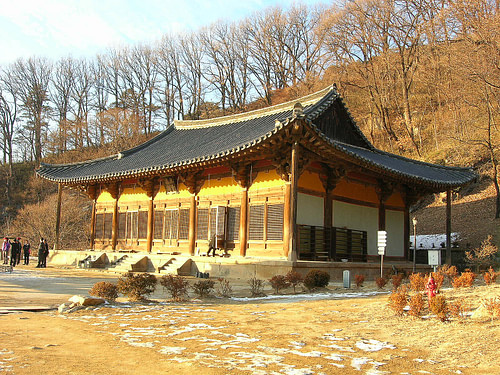
During the Mongol dominance of Korea in the late Koryŏ (Goryeo) era, Buddhism became closely allied to the Mongol establishment. Thus, the revolutionaries who eventually overthrew the Koryŏ (Goryeo) system had two reasons for despising Buddhism; a political and nationalist one and an intellectual and moral one. When the Neo-Confucian 'revolutionaries' came to power they attempted to create a model Confucian society, as well as having a model Confucian government. This was a new event in Korean history. The government actively promoted the Confucianisation of society as well as of the government, to either tightly control Buddhism or eradicate it entirely from the Korean peninsula. At the start of the dynasty, most of the temples were closed and many monks were laicised.
Although this policy of closing monasteries and limiting the number of monastics (monks and nuns) varied over the centuries, nonetheless tight control of Buddhism was deemed a necessary feature of good moral government. At two points in the 16th century CE, the government attempted to eradicate Buddhism by closing all the monasteries and forbidding anyone to become a monk. These policies were reversed, but it did mean that the state of Buddhism in Chosŏn (Joseon) Korea was the reverse of what it had been in Koryŏ (Goryeo) Korea, and very different from its contemporary situation in either China or Japan. One law passed in the middle of the dynasty indicates just how far Buddhism had fallen from grace. Buddhist clerics were legally classified as members of the 'outcast' group which included butchers, prostitutes, and slaves. In the Koryŏ (Goryeo) era, members of noble families – even one potential king – were members of Buddhist monastic orders.
JBW: How would you characterize the legacy of ancient and medieval Buddhism in modern Korea, Professor Grayson?
JHG: As we mentioned above, there was a radical change in the condition of Buddhism in Korea from the end of the 14th century CE. Whereas under the previous dynasty Buddhism had an honoured place in the culture and society, for half a millennium afterwards, Buddhism was severely suppressed. Recent Korean scholarship on the state of Buddhism in the Chosŏn (Joseon) period has stressed how and in what ways Buddhism survived and maintained itself. This is a good corrective to the general attitude that nothing worth mentioning had happened. Nonetheless, the condition of Buddhism in Korea before the 20th century CE was dire. The dishonored state of Buddhism in the Chosŏn (Joseon) was markedly different from its condition in China, Japan, or Vietnam.
This perilous state began to change in the late 19th century CE, as the power of the Chosŏn (Joseon) state began to crumble, and many younger Confucian 'progressives' began to question the intellectual and moral foundations of the state and society. Three things happened: first, there was a movement from the end of the 19th century CE to reform and purify Buddhist monastic practice; second, Protestant Christianity entered Korea from the mid-1880s CE, and its rapid growth and its social practices provided both a model and a competitive stimulus for the development of Buddhism in the 20th century CE; thirdly, following the annexation of Korea into the Japanese Empire in 1910 CE, the colonial government supported Buddhism as a counter-balance to Protestant Christianity because of its associations with the independence movement.
The movement started by monks such as Kyŏnghŏ (Gyeongheo) from the 1880s CE for the purification of monastic practice led directly to the restoration and extension of Buddhist monastic life. The result of this can be seen in the current vibrant monastic communities in the temples throughout South Korea. The great and famous temples in Japan today often have depleted monastic communities, in contrast to the temple life Korea.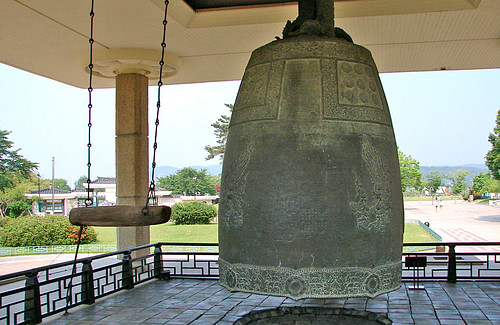
The final factor in the growth of Buddhism in the early 20th century CE was the support given to it by the Japanese colonial government. In terms of the long-term effect, this support had on its development in the modern era. Buddhism was not harmed by it (in terms of being the object of nationalist anger), and it did benefit financially by, for example, the donations of significant tracts of land around the major historic temples which were all deep in the mountains.
In sum, the growth of Buddhism in the modern day was due to an internal movement for monastic purification, the rise of the organized role of the laity in Buddhist life based on Protestant models, and the support received from the colonial regime. The influence of pre-modern Buddhism on Korean society and culture today is perhaps slight. However, the historic cultural and artistic impact on Korea is great. Anyone going hiking in the numerous mountains of Korea will inevitably visit one of the great (or lesser) temples and admire their art and architecture. National and provincial museums are full of Buddhist religious art (in stone or metal). Korea is the possessor of the most complete compendium of the East Asian Buddhist scriptures the Tripitaka Koreanum, which has been placed on over 80,000 double-sided wooden printing blocks and housed at the great Haein-sa temple. For a millennium and a half Buddhism influenced the artistic, cultural, and religious life on the Korean peninsula and this was not entirely wiped away during the 500 years of the Chosŏn (Joseon) kingdom.
JBW: Professor Grayson, I thank you so much for your time and consideration! On behalf of Ancient History Encyclopedia, I wish you many happy adventures in research.
JHG: Thank you for asking me to introduce some aspects of Buddhism in Korea. I hope that your readers will be stimulated to look more deeply into the history of Buddhism there and also to study the history of Confucianism and Christianity in Korea as well.
Nota Bene: Romanization of the Korean language is fraught with challenges, and it is the bane of linguists and academics alike. In this interview, we have favored the McCune–Reischauer System with the Revised Romanization of Korean placed in parentheses. Example: Chosŏn (Joseon). The sole exception is with regard to images, which were uploaded and published prior to the publication of this interview.
This content was made possible with generous support from the British Korean Society.
